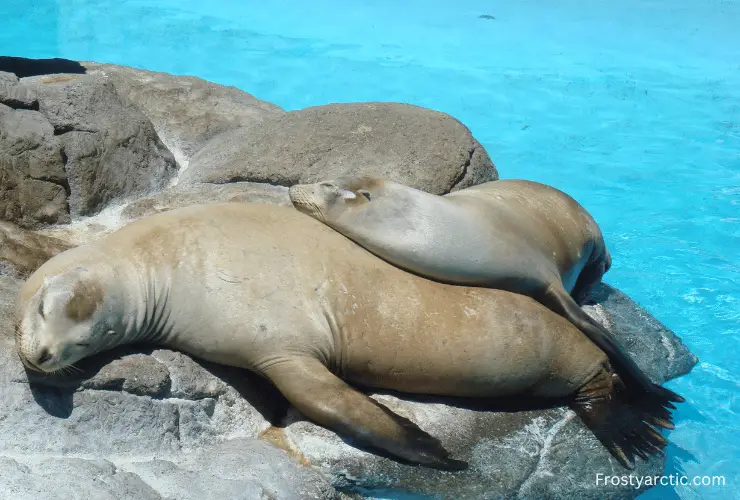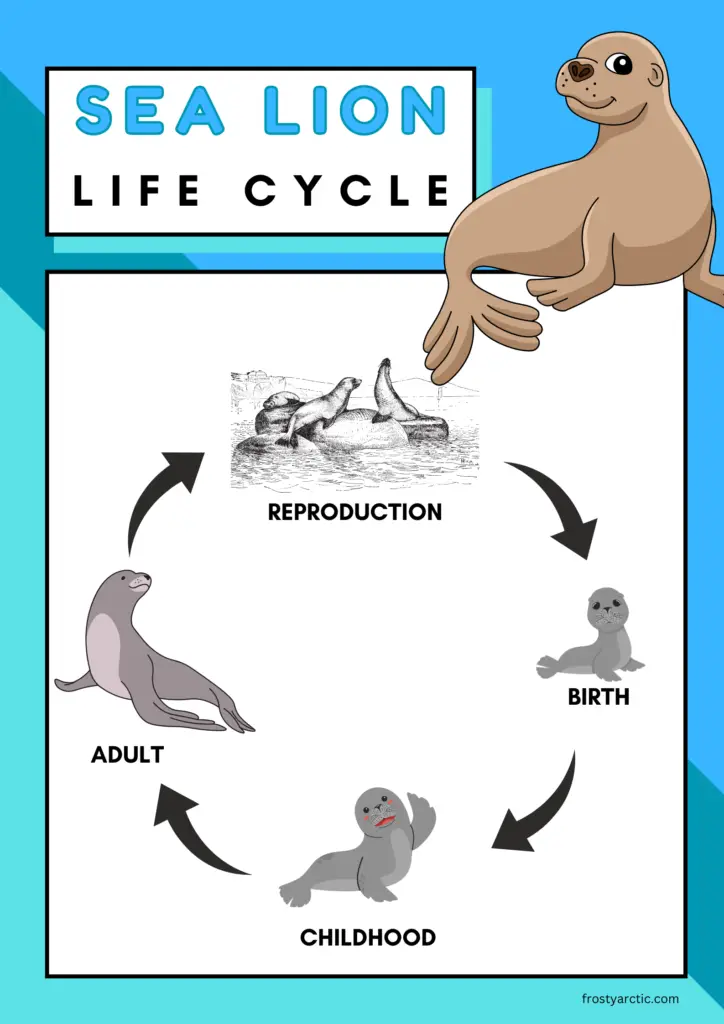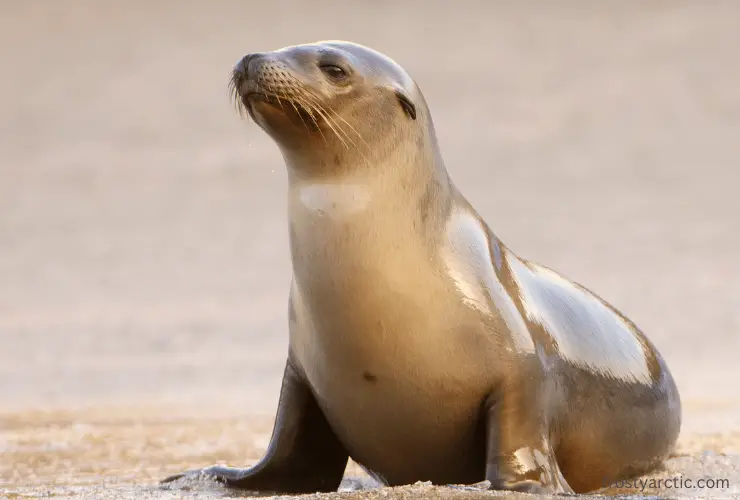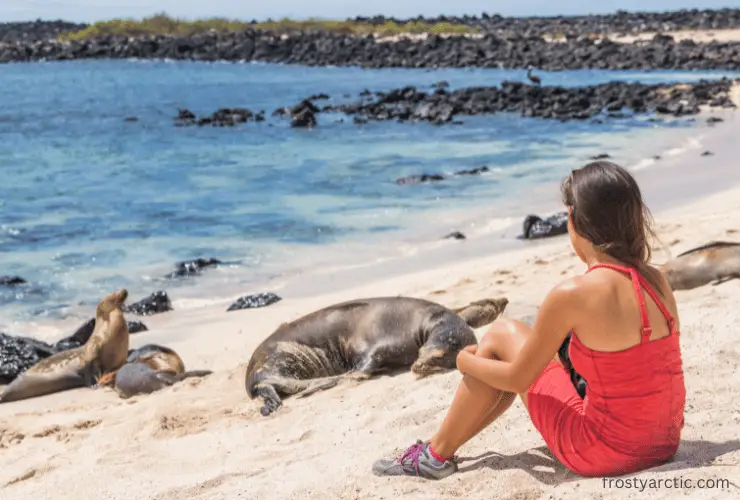A sea lion’s normal lifespan is roughly 20 years. However, some have been known to survive into their 30s depending on the environment they are living in. Scientists have observed that male sea lions tend to have shorter lifespans than females. However, threats such as predation or habitat loss can even further shorten their lifespan.
Interestingly, the maturation layers in their teeth are similar to counting rings in a tree trunk, which is used to calculate their age. The following article explains the sea lions’ lifespan, survival hazards, and entire life cycle. So, let’s get started.
How Long Do Sea Lions Live in the Wild?
Sea lions are marine mammals belonging to the Otariidae family. They can be found in every ocean except the North Atlantic Ocean.
As sea lions have different species, an average sea lion in the wild can survive for up to 20 years.
However, their lifespan in the wild can be influenced by various factors such as food availability, weather, and predation.
The longest-lived sea lion, belonging to the Steller species, can live up to 30 years in the wild.
How Long Do Sea Lions Live in Captivity?

Sea lions in zoological captivity can live up to 30 years or more.
The oldest sea lion duke in the Cincinnati Zoo, Ohio, lived in captivity for up to 31 years. The median life expectancy of this species is 25 years old in captivity.
According to the care team member Lisa Potter, Duke’s appetite decreased in his last days, and his nutritionist and mammal specialist observed many behavioral changes.
However, still, he participated in the training and indulged in fun activities. Duke’s longevity indicates the extraordinary care he received in captivity. ~ Cincinnatizoo
Sea Lion Species and Their Lifespans
There are 6 species of sea lions belonging to the scientific group Pinniped, meaning “Wingfoot or feather foot.” Let’s look at the lifespan of each species.
| Name | Habitat Area | Life Span |
| Steller Sea lion | Central California/ South Korea/ Japan | Male 20 years; Female 30 years |
| California Sea lion | Galápagos Islands/ Canada/ Mexico | Male and female 15-25 years |
| Australian Sea-lion | Australia | Male and female 17-25 years |
| New Zealand Sea lion | New Zealand /Auckland | Male and female 23 years |
| Galapagos Sea lion | Galapagos Islands | Male and female 15-24 years |
| Southern Sea lion | South America/Falkland Islands | Male and female 20 years |
The Life Cycle of Sea Lions
Let’s study more about the lifecycle of sea lions.

Reproduction
Sea lions are polygamous, which means they mate with several partners. The breeding period for sea lions differs according to species and region, although it usually occurs throughout the spring and summer.
During the mating season, male sea lions (bulls) do not eat as they are more concerned with defending their area and preventing their female partners from leaving with another male.
Female sea lions (cows) attain sexual maturity between the ages of 3 and 8. In contrast, males reach sexual maturity between the ages of 6 and 10.
The bull watches over its “Harem,” which is basically a group of cows gathered in a group. The bull’s responsibility is to protect this harem at all costs.
Birth
The breeding season lasts from late June to early August, with most pups born between May and June. Once the egg has been fertilized within the female, she might delay implantation to prevent the embryo from developing.
This delayed implantation can extend up to three months with a 9-month gestation period on average.
Approximately after 20 to 30 days, the sea lions mate again after giving birth to the pup. Therefore the female sea lion leaves for only one month when she is not pregnant.
The mother feeds the pup through an abdominal teat for 6 to 12 months.
One interesting fact is that sea lion milk contains 35% fat, 9% protein, and 0.6% lactose milk. This gives the pup the energy to grow faster.
Childhood
After the pups are born, they are usually about 75 cm and weights around 6 kg. ~ Seaworld.org
A female is very vigilant of her pup for the first two to four days. Aggressive, nearly territorial displays and open-mouth threats to other females are widespread.
The Sea lion pups imitate adult behavior to learn ways. They begin to form groups when they are two to three weeks old. Pups in these groups gain vocal, social, and swimming abilities by interacting with others. These social groupings split when the adults depart the rookery after the mating season.
Adulthood
Adult male sea lions may grow up to 8 feet long and 700-1,000 pounds. Conversely, female sea lions are smaller than males – they are, on average, 6.5 ft long and upto 240 lbs.
The large bump of bone on the top of the head, known as the Sagittal crest in adult males, is what makes them unique and different from female sea lions. Adult males’ heads become light tan as they age, while adult females have a lighter golden color.
Female sea lions attain sexual maturity between the ages of 3 and 8, while males gain sexual maturity between the ages of 6 and 10.
How Do Age is Determined of Sea Lions?

You can determine the age of sea lions by counting growth layer groups (GLGs) in tooth dentine.
This is a typical approach for assessing the age of marine mammals. Counting growth layers in their teeth is similar to counting rings in a tree trunk.
Like many animals, sea lions have a systematic tooth eruption cycle. Through teeth examination, experts can determine a sea lion’s age based on the tooth growth stage and the degree of wear.
Another way to determine sea lions’ age is that they develop fairly consistently, and their height and weight might indicate their age. Younger sea lions are smaller and less bulky than adults. Also, sea lion teeth are white and gradually become black-pigmented as they age.
In rare situations, researchers may tag or label individual sea lions and then recapture them later. Between 1991 and 2013, samples were collected from tagged sea lions. In the sea lions who were about 10 years old, the estimations were accurate within the known age for approximately 71-79% of them.
The finding supports the validity of counting GLGs to determine sea lions’ age.
How Do Sea Lions Die?
Let’s look at the natural and man-made factors that impact the lifespan of sea lions.
Stress and Disease
Stress and illness can shorten a sea lion’s life. Like other animals, sea lions can feel stress in reaction to various circumstances, including changes in their habitat, social dynamics, or physical health.
Aside from stress, sea lions can be impacted by a variety of illnesses and health concerns. Bacterial and viral infections, parasites, and other illnesses
For example, in recent studies, thousands of sea lions are affected by Algae Bloom, which generates domoic acid.
Domoic acid is deadly to animals but does not affect humans. In an excessive amount, it harms the brain of a sea creature, causing convulsions, unpredictable behavior, bulging eyes, and foaming at the mouth. Pregnant sea lions are most affected by this disease.
Human Interference

Human intervention can have a major influence on sea lion survival. Humans provide a number of hazards to sea lions, including habitat loss, pollution, and poaching.
Sea lions face significant danger from habitat loss, which can limit their availability of food, shelter, and other resources. Development of the agricultural sector and fishing may all impact sea lion habitats, decreasing the availability of appropriate sites for them to dwell and reproduce.
Another important hazard to sea lions is pollution. Oil, chemicals, and plastic can enter the water and be consumed by sea lions, potentially causing disease or death.
Predators
Several creatures, including other marine mammals and multiple shark species, feed on sea lions. Killer whales, sharks, and seals are among the most common predators of sea lions.
Killer whales frequently hunt sea lions and have been observed to attack sea lions of all sizes, from small pups to older males.
Seals have also been spotted preying on sea lions, especially when they are young and defenseless. Some seal species, such as the leopard seal, are notoriously violent and can fight sea lions for food.
FAQs
Q: How Long Can Sea Lions Live Without Food?
A: During the breeding season, a male sea lion can go without food for 27 days to protect his beach area.
Q: What Affects the Most of Sea Lions’ Life Span?
A: The most significant factors that affect the sea lion’s life span are the availability of food and environmental conditions. Habitat destruction and human activities can also impact their life span. ~ Worldwildlife.org
Conclusion
Natural variables like predation, food availability, environmental conditions, and man-made risks such as pollution, habitat degradation, and human activity impact the lifespans of sea lions. The continuous veterinarian care and well-balanced nourishment in these environments can contribute to their long life.
WWF assisted in funding a project on San Cristóbal Island that constructed and placed two floating platforms for sea lions to rest on and a “primary care nursery” for sea lions and other species. These types of programs or projects can increase the longevity of their lifespan.
Moreover, countries such as Australia have particular recovery programs for increasing the lifespan of endangered sea lion species. The Western Australian government built a network of sea lion conservation zones around known breeding colonies in 2018.



3 thoughts on “How Long Do Sea Lions Live? [Lifecycle Explained]”